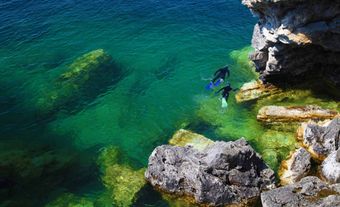Somerset Island, 24 786 km2, ninth-largest island in the ARCTIC ARCHIPELAGO. Its western part is on Precambrian bedrock, reaching an elevation of 503 m, but the larger part is an elevated plateau of sedimentary rocks. Vegetation is scant, except in some depressions and lowlands where Peary caribou are common. Muskoxen are making a comeback after having been decimated by whalers around the turn of the century. Hundreds of thousands of birds nest on the sheer cliffs of Prince Leopold I, off the NE tip of Somerset. The island was named by Lt W.E. PARRY, who discovered it in 1819, after the county in England.
-
- MLA 8TH EDITION
- Zoltai, S.C.. "Somerset Island". The Canadian Encyclopedia, 27 March 2014, Historica Canada. www.thecanadianencyclopedia.ca/en/article/somerset-island. Accessed 23 December 2024.
- Copy
-
- APA 6TH EDITION
- Zoltai, S. (2014). Somerset Island. In The Canadian Encyclopedia. Retrieved from https://www.thecanadianencyclopedia.ca/en/article/somerset-island
- Copy
-
- CHICAGO 17TH EDITION
- Zoltai, S.C.. "Somerset Island." The Canadian Encyclopedia. Historica Canada. Article published February 07, 2006; Last Edited March 27, 2014.
- Copy
-
- TURABIAN 8TH EDITION
- The Canadian Encyclopedia, s.v. "Somerset Island," by S.C. Zoltai, Accessed December 23, 2024, https://www.thecanadianencyclopedia.ca/en/article/somerset-island
- Copy
Thank you for your submission
Our team will be reviewing your submission
and get back to you with any further questions.
Thanks for contributing to The Canadian Encyclopedia.
CloseArticle
Somerset Island
Article by S.C. Zoltai
Published Online February 7, 2006
Last Edited March 27, 2014
Somerset Island, 24 786 km2, ninth-largest island in the ARCTIC ARCHIPELAGO. Its western part is on Precambrian bedrock, reaching an elevation of 503 m, but the larger part is an elevated plateau of sedimentary rocks.

 Share on Facebook
Share on Facebook Share on X
Share on X Share by Email
Share by Email Share on Google Classroom
Share on Google Classroom

